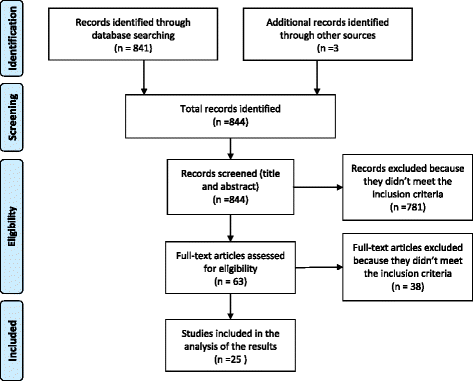Identification of clinical phenotypes in knee osteoarthritis: a systematic review of the literature
- PMID: 27733199
- PMCID: PMC5062907
- DOI: 10.1186/s12891-016-1286-2
Identification of clinical phenotypes in knee osteoarthritis: a systematic review of the literature
Abstract
Background: Knee Osteoarthritis (KOA) is a heterogeneous pathology characterized by a complex and multifactorial nature. It has been hypothesised that these differences are due to the existence of underlying phenotypes representing different mechanisms of the disease.
Methods: The aim of this study is to identify the current evidence for the existence of groups of variables which point towards the existence of distinct clinical phenotypes in the KOA population. A systematic literature search in PubMed was conducted. Only original articles were selected if they aimed to identify phenotypes of patients aged 18 years or older with KOA. The methodological quality of the studies was independently assessed by two reviewers and qualitative synthesis of the evidence was performed. Strong evidence for existence of specific phenotypes was considered present if the phenotype was supported by at least two high-quality studies.
Results: A total of 24 studies were included. Through qualitative synthesis of evidence, six main sets of variables proposing the existence of six phenotypes were identified: 1) chronic pain in which central mechanisms (e.g. central sensitisation) are prominent; 2) inflammatory (high levels of inflammatory biomarkers); 3) metabolic syndrome (high prevalence of obesity, diabetes and other metabolic disturbances); 4) Bone and cartilage metabolism (alteration in local tissue metabolism); 5) mechanical overload characterised primarily by varus malalignment and medial compartment disease; and 6) minimal joint disease characterised as minor clinical symptoms with slow progression over time.
Conclusions: This study identified six distinct groups of variables which should be explored in attempts to better define clinical phenotypes in the KOA population.
Keywords: Clinical; Knee; Osteoarthritis; Phenotype; Sub-group.
Figures
Similar articles
-
Knee internal contact force in a varus malaligned phenotype in knee osteoarthritis (KOA).Osteoarthritis Cartilage. 2017 Dec;25(12):2007-2013. doi: 10.1016/j.joca.2017.08.010. Epub 2017 Sep 4. Osteoarthritis Cartilage. 2017. PMID: 28882753
-
Classification of patients with knee osteoarthritis in clinical phenotypes: Data from the osteoarthritis initiative.PLoS One. 2018 Jan 12;13(1):e0191045. doi: 10.1371/journal.pone.0191045. eCollection 2018. PLoS One. 2018. PMID: 29329325 Free PMC article.
-
Metabolic and inflammatory profiles define phenotypes with clinical relevance in female knee osteoarthritis patients with joint effusion.Rheumatology (Oxford). 2023 Dec 1;62(12):3875-3885. doi: 10.1093/rheumatology/kead135. Rheumatology (Oxford). 2023. PMID: 36944271 Free PMC article.
-
A systematic review and meta-analysis of lower limb neuromuscular alterations associated with knee osteoarthritis during level walking.Clin Biomech (Bristol). 2013 Aug;28(7):713-24. doi: 10.1016/j.clinbiomech.2013.07.008. Epub 2013 Aug 15. Clin Biomech (Bristol). 2013. PMID: 23953330 Review.
-
Are biomechanical factors, meniscal pathology, and physical activity risk factors for bone marrow lesions at the knee? A systematic review.Semin Arthritis Rheum. 2013 Oct;43(2):187-94. doi: 10.1016/j.semarthrit.2013.03.002. Semin Arthritis Rheum. 2013. PMID: 24157092 Review.
Cited by
-
Accuracy of magnetic resonance imaging in assessing knee cartilage changes over time in patients with osteoarthritis: A systematic review.North Clin Istanb. 2022 Sep 5;9(4):414-418. doi: 10.14744/nci.2021.34270. eCollection 2022. North Clin Istanb. 2022. PMID: 36276575 Free PMC article. Review.
-
Understanding the role of diabetes in the osteoarthritis disease and treatment process: a study protocol for the Swedish Osteoarthritis and Diabetes (SOAD) cohort.BMJ Open. 2019 Dec 17;9(12):e032923. doi: 10.1136/bmjopen-2019-032923. BMJ Open. 2019. PMID: 31852705 Free PMC article.
-
Clinical Perspective on Pain and Pain Phenotypes in Osteoarthritis.Curr Rheumatol Rep. 2018 Oct 31;20(12):79. doi: 10.1007/s11926-018-0796-3. Curr Rheumatol Rep. 2018. PMID: 30382417 Review.
-
Exploring different models of pain phenotypes and their association with pain worsening in people with early knee osteoarthritis: The MOST cohort study.Osteoarthritis Cartilage. 2024 Feb;32(2):210-219. doi: 10.1016/j.joca.2023.09.003. Epub 2023 Sep 13. Osteoarthritis Cartilage. 2024. PMID: 37709187 Free PMC article.
-
EEG theta and beta bands as brain oscillations for different knee osteoarthritis phenotypes according to disease severity.Sci Rep. 2022 Jan 27;12(1):1480. doi: 10.1038/s41598-022-04957-x. Sci Rep. 2022. PMID: 35087082 Free PMC article.
References
-
- Hunter DJ, Lo GH. The management of osteoarthritis: an overview and call to appropriate conservative treatment. Rheum Dis Clin North Am. 2008;34:689–712. - PubMed
Publication types
MeSH terms
LinkOut - more resources
Full Text Sources
Other Literature Sources


